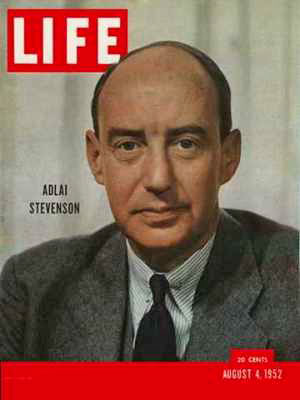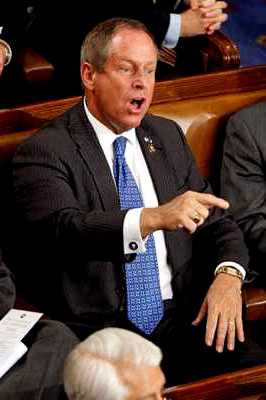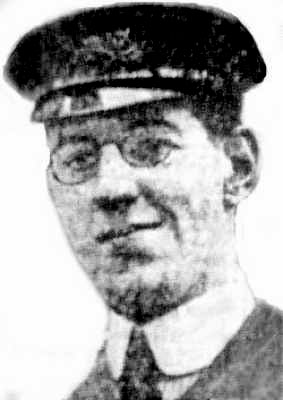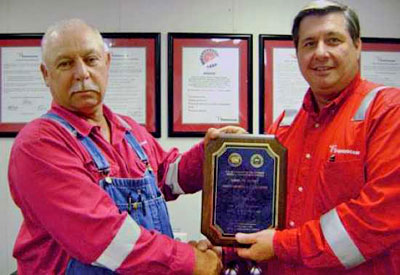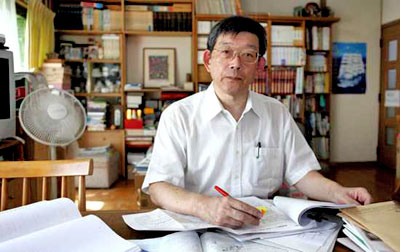|
February 9, 2012 from ListVerse Website
Here are ten examples of people who tried to
warn others, but whose warnings went unheeded.
On October 24, 1963, less than a month before President John F Kennedy was scheduled to go to Dallas as part of a campaign swing through the critical electoral state of Texas, Kennedy’s UN Ambassador Adlai Stevenson went to Dallas to speak at Dallas Memorial Auditorium to mark U.N. Day.
Many people in Dallas openly and violently hated the United Nations, Supreme Court Chief Justice Earl Warren, and the Kennedys. Their hatred was so intense that they persuaded Governor John Connally to declare the day before Stevenson’s visit “US Day” out of protest.
When Stevenson arrived at the auditorium there were thousands of picketers outside, and many inside, to protest him and the UN (and the Kennedy Administration).
As Stevenson tried to speak these protestors stamped their feet, shouted, booed, and rattled noisemakers to disrupt him. But Stevenson pressed on.
One man screamed,
After the speech, police tried to escort Stevenson out of the auditorium but the angry crowd surrounded him.
At one point Stevenson stepped out of the police protection to try to talk to a woman who was screaming at him. The woman clobbered Stevenson over the head with her picket sign.
Stevenson then said,
Upon arriving back in Washington, Stevenson warned Arthur Schlesinger, Kennedy’s speechwriter, that Kennedy should not go to Texas, or at least, avoid Dallas.
Schlesinger did not pass along the warning. Even if he had, it is doubtful Kennedy would have avoided Dallas, to do so would have seemed cowardly.
Kennedy paid for this decision with his life.
In February 2002, Vice President Dick Cheney authorized the CIA to dispatch former ambassador Joseph C. Wilson to the small African nation of Niger to see if there was anything to the rumors that Saddam Hussein and Iraq were trying to purchase yellowcake uranium for use in nuclear weapons.
Yellowcake is uranium concentrate powder (colored bright yellow) that is an intermediary step in processing raw uranium ore into weapons grade, highly enriched uranium used in nuclear weapons. As Niger has considerable natural uranium deposits, the possibility existed Iraq may have been trying to secretly buy the yellowcake to use in a possible nuclear weapons program.
Wilson consulted with the Niger Prime Minister
and came away with the conclusion that there was nothing to reports that
Iraq had sales agreements with Niger to buy yellowcake uranium. He reported
this to the CIA in March 2002.
After the invasion of Iraq by the United States, in July 2003, Wilson wrote an op-ed article for the New York Times where he disclosed the mission to Niger.
He stated that he had looked into the possibility of Iraq buying uranium and found nothing to it, and that he reported this to the CIA and White House. He implied that the President’s statement was misleading as justification for war with Iraq.
CIA Director George Tenet would later say those
words should never have been in the text of the Presidents State of the
Union address, but still believed Iraq was trying to get its hands on
nuclear material and was developing or even had developed an atomic weapon
or other weapon of mass destruction (WMD).
No WMD or any indication that Iraq had an active
or even rudimentary nuclear program was ever found.
A Military-industrial complex (MIC) is a kind of iron triangle composed of a nation’s armed forces, legislative/administrative government, and defense industry companies who work together to constantly funnel national resources into more and more military procurement.
Though such complexes have existed since man began to use technology to wage war and develop better weapons, it was in the aftermath of World War II and the rise of the atomic age that the US version of the MIC began to frighten people who worried the MIC was beginning to over power typical democratic means of restraint, moderation, and control.
No one was more concerned than President and former General Dwight Eisenhower. In his eight years as President, Eisenhower had watched the fearsome growth and power of the ever expanding and powerful United States MIC.
As he left office on January 17, 1961 in his farewell speech to the Nation, he made the following warning:
Eisenhower’s warning went unheeded.
In the US today, the MIC is larger and more powerful than ever, making it difficult to near impossible for the US to stop making massive weapons programs and expending huge amounts of its national treasure on the military, even during times of relative peace (such as the 1990s after the fall of the Soviet Union).
Today the US military budget is almost as large
as that of all other nations combined.
In the late 1800s a bunch of wealthy industrial barons led by Henry Clay Fricke decided they wanted their own private retreat from the soot, dirt, and heat of the city - a place out in the mountains of western Pennsylvania.
They purchased a dam and lake that had been built in the early 1800s as a reservoir on the Conemaugh River near Johnstown Pennsylvania and created the South Fork Fishing and Hunting Club.
They called their lake “Lake Conemaugh” and though the dam that created it had originally been well-built, over the years, due to poor maintenance and alterations, it had become more and more unstable.
By the time the industrialists bought it, it was
already leaking and in a state of disrepair. Rather than use some of their
incredible wealth to strengthen and fix the dam, they mostly made patches
using clay and straw whenever it sprung a leak, which it did quite often.
His men then made a frantic effort to dig
another spillway to take some of the pressure off the dam and divert the
water. This too failed.
Parke made it and telegraphed not one but two
warnings, both of which were never passed along to South Fork and Johnstown
officials who could have taken action and evacuated the towns. Over the
years there had been so many false alarms of the dam breaking (because of
the frequent leaks and repairs) that no one believed Parke when he told them
the dam would not hold.
The water reached the little town of South Fork first. Fortunately most of the inhabitants heard the roar of the water coming and were able to scamper up the side of the mountain to high ground and only four people were killed.
The people of Johnstown were not as fortunate. The wave of water, moving at 40 miles per hour and reaching a height of 60 feet, carrying houses, telephone poles, rocks, trees, railroad cars, and everything else in its path, slammed into the town.
An estimated 2,209 people were killed making it
the worst disaster in the history of the US at that time.
In April 1912 Cyril Evans was working as the telegraph operator on board the SS Californian on a voyage across the Atlantic.
On the night of April 14, 1912, the Captain of the Californian, Stanley Lord, brought the ship to a halt as it had entered a wide ice field with many large icebergs. Lord came into the wireless operators room and ordered Evans to warn other ships in the area of the ice.
Evans proceeded to do just that, sending out
wireless warnings to other ships in the area that they were approaching ice.
Philips received Evans’ ice warning message, but because the Californian was so close to the Titanic and Evans had his set turned to full power, he almost blew the headset off Philips head. An angry Philips told him to get off and Philips never passed along the ice warning to the bridge or the ship’s Captain.
Evans felt he had done what he was ordered to do, switched off his radio set, and went to bed.
A short time later the Titanic, heading at full
steam west toward America, came upon the ice Evans had tried to warn them
about, struck an iceberg and sank with the loss of over 1500 people.
In 2010, operations on the Deep Water Horizon oil platform, owned by BP and operated by Transocean, were not going well.
In fact, getting the oil well drilled and producing oil (and revenue) had been a nightmare from the beginning and was behind schedule. The Deepwater Horizon was drilling an exploratory well at the Macondo Prospect region located about 41 miles off the southeast coast of Louisiana, at a water depth of approximately 5,000 feet.
On April 20, 2010,
the oil rig exploded, caught
fire, and sank, killing eleven workers and causing one of the worst
environmental disasters in history.
Mud was what was typically used to pack the bottom of the rigs drill pipe before capping the well. Harrell refused to do so without conducting two leak tests. For both tests, leaks were found in the pipe allowing drilling mud to flow out and onto the drill platform. A successful test should have had no mud leaking out of the pipe.
For some reason, in spite of the leaks, Harrell went forward with the removal of the heavy mud from the pipe, replacing it with lighter seawater.
At 9:45pm a geyser of seawater, methane gas and mud
burst out of the pipe onto the platform. The gas ignited and the rig
exploded and caught fire.
Though Harrell now states he cannot remember giving BP a warning, others have testified that is exactly what he did.
At a meeting with BP officials just before the explosion, a frustrated Harrell told another employee “I guess that’s what we have the pincers for” - referring to the automatic blowout preventer which was supposed to slice into and seal the well head if the ultimate disaster happened.
The blowout preventer, along with just about
every other safety device, failed that day.
Katsuhiko Ishibashi is a well-respected professor and seismologist at Kobe University in Japan.
Since the early 2000s he has been warning Japan
that the country’s many nuclear power plants are in danger of serious damage
or even a melt down because they have been built in earthquake-prone areas.
He later resigned saying the committee’s review process was unscientific and the outcome of the committee findings were rigged in favor of the Japan Electric Association.
He also claimed the final
guide that the committee produced was flawed because it underestimated the
design basis for earthquake ground motion. Ishibashi also stated that
Japanese engineers were overconfident in their predictions of plant
engineering and safety design to withstand an earthquake.
He said:
Ishibasi once said:
All of Ishibasi’s fears came true on March 11,
2011 when a huge off shore
earthquake and resulting tsunami damaged the
Fukushima Diiachi nuclear power plant resulting in a level 7
International
Nuclear Event Scale disaster - the highest level nuclear disaster possible.
3 - Brooksley Born
When Brooksley Born took over as head of the Commodities Futures Trading Commission (CFTC), a government agency empowered with the task of monitoring and regulating the commodities exchange in the US, she very quickly discovered something that shocked her.
An entire branch of the commodities market known as Over the Counter commodities (OTC commodities) existed that were for all intents and purposes, totally unregulated. Worse, the government (which was supposed to monitor and regulate commodity trading) didn’t even know these types of commodity investments existed.
Gargantuan sums of money were being traded as
OTC commodities called “derivatives,” with no regulation and nobody even
aware it was taking place. On Wall Street they called it the “Black Box” of
trading, only those involved knew the details. And they wanted it to stay
that way.
The more she learned about OTC commodities and the derivatives markets, the more frightened she grew that something terrible would happen to the US and world economies. Born was most worried about the derivatives and swaps markets - where the risk associated with investments were traded as insurance policies.
These were complicated financial investments understood by very few people, and banks began to fraudulently sell them to unsuspecting customers who did not fully understand what they were buying, and who ended up losing huge sums of money.
Born believed that it was the job of her agency to investigate and prosecute such fraud.
Alan Greenspan had other ideas
about that. Greenspan, who more then any other single individual can be
blamed for the US financial and economic collapse of 2008, believed,
foolishly and naively, that regulation and enforcement was unnecessary -
that banks, financial firms, and business could “regulate themselves.”
But the warnings she had made about the unregulated OTC derivatives market becoming far too large and posing a threat to the very structure of the US and world economy did not go away.
By 2007 just before the crash, the OTC derivatives market was valued at a mind-numbing $595 trillion.
Derivatives were being written to insure derivatives, which were themselves written on derivatives. It was a house of cards of financial debt waiting to fall, all it needed was a triggering event.
And the collapse of the housing market did just that. In a matter of months the huge load of debt, most of it in the form of “credit default swaps” and derivatives, led to the fall of Lehman Brothers, which triggered an almost complete collapse of the US financial market.
Only emergency influx of US taxpayer money to buy the worthless “toxic assets” off the books of banks and large investment houses, saved the US economy from plunging into another Great Depression.
And she has another warning, even after the collapse of 2008:
John O’Neil was an FBI agent who, more than anyone else in the agency, was actively investigating the terrorist group Al-Qaeda in the 1990s and the links between state sponsors of terrorism such as Yemen and Saudi Arabia, Al-Qaeda operatives, and attacks on US interests around the world including the 1993 attack on the World Trade Center buildings.
The more O’Neil dug into the shadow world of international terrorism, the more he began to warn anyone in Washington DC that would listen, that Al-Qaeda and Osama bin Laden were major threats to the US.
Throughout the 1990s, with the first attack on the World Trade center buildings, the attacks on US embassies, and the attack on the US Cole, all being "linked" to Al-Qaeda, O’Neil and his predictions were turning out to be true. Yet his personal style stepped on the shoes of powerful people in Washington DC and FBI headquarters, many of whom were jealous of his successful predictions.
By August 2001, his enemies had pushed him out of the FBI.
O’Neil resigned to take the job as head of security for the World Trade Center buildings. One of his friends told him he had taken the perfect job because Al-Qaeda had already attacked there and he was safe. O’Neil disagreed and said that he thought Al-Qaeda was coming back to the World Trade Centers to finish the job.
The night before the attacks in a conversation with another friend, O’Neil told him that he felt an attack on US soil was going to happen, and happen in a matter of days or weeks.
He was still monitoring activities coming out of
Afghanistan and felt, in his stomach, that the attack was coming, and soon.
This terrorist told the FBI of a meeting in Malaysia attended by two of the Al-Qaeda terrorists who had participated in the attack and bombing of the US Cole. These two had been moving in and out of the United States and practicing on flight school simulators.
They would be two of the Al-Qaeda terrorists who
on September 11, 2001, crashed flight 77 into the Pentagon.
For more information on John O’Neil and his
incredible story, see the PBS Frontline documentary called “The Man Who
Knew.”
In the 1980s Roger Boisjoly worked as an engineer at Morton Thiokol, maker of the solid rocket boosters used in the space shuttle program.
In 1985, a year before the
space shuttle
Challenger disaster, Boisjoly had been warning Thiokol that the joints used
to seal the sections of the solid rocket boosters could fail if they became
too cold before launch.
Boisjoly and other Thiokol engineers had found
that in cold weather conditions, the rubber material in the o-rings became
brittle and did not seal the sections into place. In this case, the o-ring
would fail to prevent the flames from reaching the rocket’s metal casing. If
this happened, the flames could trigger a huge explosion of the hydrogen
fuel tank located right next to the boosters.
The weather forecast for Cape Canaveral was to be unusually cold with temperatures dropping below freezing. All of that evening and into the morning hours of January 28, Boisjoly and other engineers pleaded with NASA to delay the launch. Senior managers at Thiokol and NASA officials rejected their argument. NASA insisted the shuttle would launch the morning of January 28 as scheduled, even with the cold weather.
Only a minute after taking off, the o-ring on one of the solid fuel rocket boosters failed just as Boisjoly had predicted it would.
The flames shot out from the booster and hit the
hydrogen tank, which exploded, killing all of the astronauts on board.
Boisjoly was so sure that the booster o-rings would fail, he could not make
himself watch the launch.
In 2003 when an unchanged NASA culture caused
the
disintegration of the shuttle Columbia, Boisjoly stated that NASA
engineers and administrators should be charged with murder and the only way
to change the NASA culture was to throw people in jail.
|

